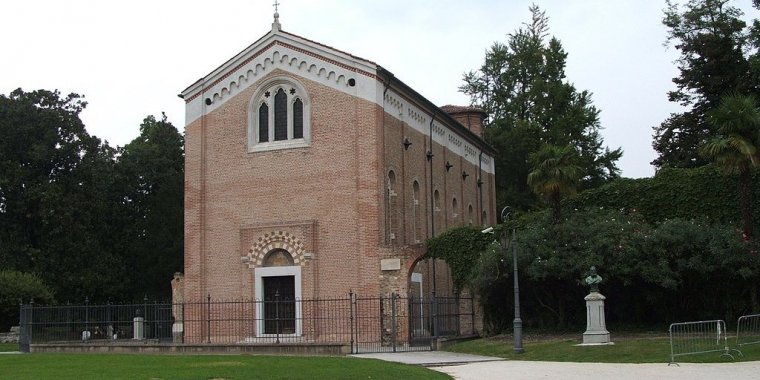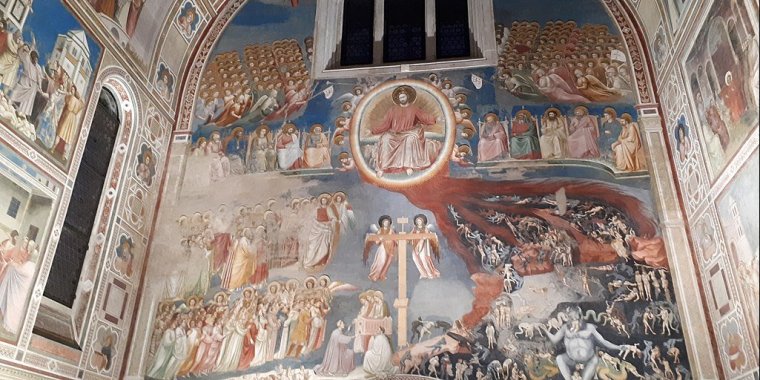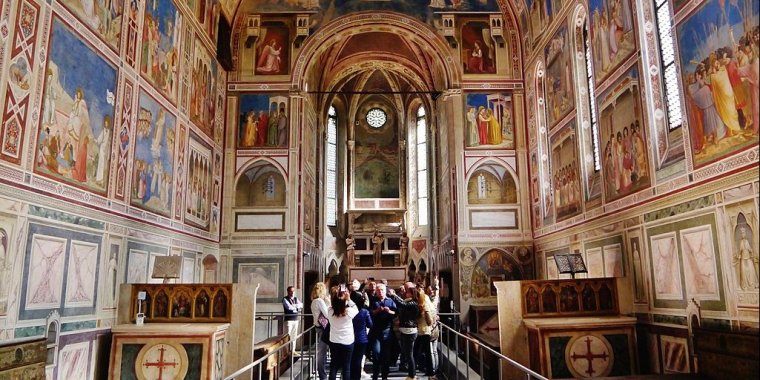| Travel / Tourist Attractions |
Scrovegni Chapel (Cappella degli Scrovegni), Padua, Italy

Scrovegni Chapel, Padua, Italy. ![]()
The Scrovegni Chapel (Cappella degli Scrovegni), also known as the Arena Chapel, is a small church, adjacent to the Augustinian monastery, the Monastero degli Eremitani in Padua, region of Veneto, Italy. The chapel and monastery are now part of the complex of the Museo Civico of Padua. The chapel contains a fresco cycle by Giotto, completed about 1305 and considered to be an important masterpiece of Western art.
Giotto and his team covered all the internal surfaces of the chapel with frescoes, including the walls and the ceiling. The nave is 20.88 metres long, 8.41 metres wide, and 12.65 metres high. The apse area is composed of a square area (4.49 meters deep and 4.31 meters wide) and a pentagonal area (2.57 meters deep).
The largest element is extensive cycles showing the Life of Christ and the Life of the Virgin. The wall at the rear of the church, through which the chapel is entered, has a large Last Judgement. There are also panels in grisaille (monochrome) showing the Vices and Virtues.
The church was dedicated to Santa Maria della Carità at the Feast of the Annunciation, 1303, and consecrated in 1305. Much of Giotto's fresco cycle focuses on the life of the Virgin Mary and celebrates her role in human salvation. A motet by Marchetto da Padova appears to have been composed for the dedication on 25 March 1305.
The chapel is also known as the Arena Chapel because it was built on land purchased by Enrico Scrovegni that abutted the site of a Roman arena. The space was where an open-air procession and sacred representation of the Annunciation to the Virgin had been played out for a generation before the chapel was built.
The Arena Chapel was commissioned to Giotto by the affluent Paduan banker, Enrico Scrovegni.
Giotto, who was born around 1267, was 36–38 years old when he worked at Enrico Scrovegni's chapel. He had a team of about 40 collaborators, and they calculated that 625 work days (giornati) were necessary to paint the chapel. A "work day" meant that portion of each fresco that could be painted before the plaster dried and was no longer "fresh" (fresco in Italian ).
The chapel was originally connected with the Scrovegni palace, which was built on what remained of the foundations of the elliptical ancient Roman arena. The palace was demolished in 1827 in order to sell the precious materials it contained and to erect two condominiums in its place.
The chapel was purchased by the Municipality of the City of Padua in 1881, a year after the City Council's deliberation of 10 May 1880 leading to a decision to demolish the condominiums and restore the chapel.
In June 2001, following a preparation study lasting over 20 years, the Istituto Centrale per il Restauro (Central Institute for Restoration) of the Ministry for Cultural Activities, in collaboration with Padua's Town Hall in its capacity of owner of the Arena Chapel, started a full-scale restoration of Giotto's frescoes under the late Giuseppe Basile's technical direction.
The depiction of the sacred stories, and the message of the vault
Giotto frescoed the chapel's whole surface, including the walls and the ceiling. The fresco cycle is organised along four tiers, each of which contains episodes from the stories of the various protagonists of the Sacred History. Each tier is divided into frames, each forming a scene.
The chapel is asymmetrical in shape, with six windows on the longer south wall, and this shape determined the layout of the decoration. The first step was choosing to place two frames between each double window set on the south wall; secondly, the width and height of the tiers was fixed in order to calculate the same space on the opposite north wall.

Cappella degli Scrovegni - Interior. ![]()
Cycles of scenes showing the Life of Christ and the Life of the Virgin were the grandest form of religious art in the period, and Giotto's cycle is unusually large and comprehensive, showing the ambition of the commission. Allowing for this, the selection and iconography of the scenes is broadly comparable to other contemporary cycles; Giotto's innovation lies in the monumentality of his forms and the clarity of his compositions.
The cycle recounts the story of salvation. It starts from high up on the lunette of the triumphal arch, with the uncommon scene of God the Father instructing the Archangel Gabriel to perform the Annunciation to Mary. The narrative continues with the stories of Joachim and Anne (first tier from the top, south wall) and the stories of Mary (first tier from the top, north wall). After a return to the triumphal arch, the scenes of the Annunciation and the Visitation follow.
The stories of Christ were placed on the middle tier of the south and north walls. The scene of Judas receiving the money to betray Jesus is on the triumphal arch. The lower tier of the south and north walls shows the Passion and Resurrection; the last frame on the north wall shows the Pentecost. The fourth tier begins at ground level with the monochromes of the Vices (north wall) and the Virtues (south wall). The west wall (counter-façade) presents the Last Judgment.

Choir Frescoes of the Scrovegni Chapel. ![]()
The scenes depicted are as follows:
Sacred stories:
Triumphal arch (lunette):
• The Annunciation to Mary;
Upper tier, south wall:
• The Expulsion of Joachim
• Joachim amongst the shepherds
• An angel comes to Anna in prayer announcing the birth of Mary
• Joachim sacrifices a kid goat to the Lord
• Joachim's dream
• Joachim meets Anna at the Golden Gate
Upper tier, north wall:
• Nativity of Mary and her bathing as an infant
• Presentation of Mary at the Temple
• The bringing of the branches
• Prayer for the blossoming of the branches
• The marriage of the Virgin
• The nuptial cortege
Triumphal arch:
• The Annunciation
• Visitation
Middle tier, south wall:
• The Nativity of Jesus
• The Adoration of the Magi
• The Presentation of Jesus at the Temple
• The Flight into Egypt
• The Massacre of the Innocents
Middle tier, north wall:
• The Finding in the Temple (Jesus among the doctors)
• The Baptism of Jesus
• The Wedding at Cana
• The Resurrection of Lazarus
• Christ enters Jerusalem
• Casting out the money changers
Triumphal arch:
• Judas's betrayal
Lower tier, south wall:
• The Last Supper
• The washing of the feet
• The Kiss of Judas
• Jesus before Caiaphas
• Flagellation of Christ
Lower tier, north wall;
• The ascent to Calvary
• Crucifixion
• Lamentation of Christ
• The Resurrection of Jesus — Noli me tangere
• Ascension
• Pentecost
Bottom tier, north wall: Vices:
• Stultitia
• Inconstantia
• Ira
• Iniustitia
• Infidelitas
• Invidia
• Desperatio
Bottom tier, south wall: Seven virtues:
• Prudence
• Fortitude
• Temperance
• Justice
• Faith
• Charity
• Hope
Counter-façade:
• The Last Judgment
The vault presents the eighth day, the time of eternity, God's time, with eight planets (the tondos which enclose the seven great prophets of the Old Testament plus John the Baptist) and two suns (which show God and the Madonna and Child), while the blue sky is studded with eight-point stars (8, sideways, symbolises infinity).

Frescoes of the Scrovegni Chapel. ![]()
The monochrome personifications of Vices and Virtues
The bottom tiers of the side walls feature 14 personifications in grisaille, representing single figures of Vices on the north wall and Virtues on the south wall. The Vices are Stultitia, Inconstantia, Ira, Iniusticia, Infidelitas, Invidia, and Desperatio.
The Virtues are grouped as follows: the four cardinal virtues: Prudentia, Iustitia, Temperantia, Fortitudo, followed by the three theological ones: Fides, Karitas, Spes.
Each virtue and vice is embedded within a mirror-like marble frame. The name of the vice or the virtue is written in Latin on top of each figure, indicating what these figures represent, namely, the seventh day (the time between Jesus's birth and the Final Judgement).
According to the controversial theory of Giuliano Pisani, the Vices and Virtues read starting from the altar's side, going towards the counter-façade (Final Judgement), and the sequence is not "Vices first, then Virtues" as was long believed. It rather proceeds from Vice 1 (Stultitia) (north wall, right hand side) to Virtue 1 (Prudencia) (south wall, left hand side), to Vice 2 (Inconstantia) (north wall) to Virtue 2 (Fortitudo) (south side), and so on.
Vices and Virtues symbolise humanity's progress toward bliss (heavenly happiness). With the aid of Virtues, humanity can overcome obstacles (Vices). This is the philosophical-theological itinerary designed by Giotto's theologian, a learned theologian who drew his inspiration from Saint Augustine.
The Vice-Virtue section of the Arena Chapel illustrates the philosophical-theological message underlying the overall project and is key to clarifying several points previously considered to be either obscure or the result of Giotto's only approximate theological knowledge.
For instance, in the Arena Chapel the vices are not the traditional capital vices or deadly sins (Pride, Envy, Wrath, Sloth, Greed, Gluttony and Lust), just like the "corresponding" virtues do not reflect the traditional order, consisting in four "cardinal virtues" (Prudence, Justice, Fortitude and Temperance) and three "theological virtues" (Faith, Hope and Charity).
A twofold therapeutic path leading to salvation is presented. The first, composed of four virtues, brings a cure by means of the opposing force provided by the cardinal virtues. The arrival point in this first part of the itinerary is Justice, Iusticia, who makes peace possible and therefore ensures Paradise on earth and earthly happiness.
The first Vice in this first section is Stultitia, namely the incapacity to distinguish good and evil. Its cure (opposite wall) is Prudencia, Prudence, which in classical and theological terms is not "cautiousness" but "moral intelligence" or the capacity to distinguish good and evil. The viewer is in the sphere of Knowledge.
Next comes the pair Inconstantia, Inconstancy, (north wall) and Fortitudo, Fortitude, (south wall). Fortitude (moral and mental strength) triumphs over Inconstancy's lewd oscillations by means of will. "Inconstancy" is literally "the lack of a stable seat"; it is a mix of light-headedness, volubility, and inconsistency. "Inconstancy" is portrayed as a young woman rolling over a ball, ready to fall, on a motley marble floor signifying the lack of "unity" ("constancy") which characterizes an inconstant mind. Here is the sphere of Will. Wrath, the third vice, is "tempered" by Temperantia, Temperance.
According to Saint Augustine, Temperantia is the inner balance which ensures the will's stable dominion over instincts and keeps human desires within the boundaries of honesty. It is the therapy necessary to prevail over passions, which are symbolized by Wrath, because Wrath is the most perilous of all the passions: it is sudden and destructive, even against own's dearest ones, and is therefore the passion that human beings first need to learn how to control.
This notion is a tenet of ancient Greek and (in its footprints) Roman philosophy, which Saint Augustine made his own and Giotto's theologian transmitted to him, fusing together a number of Saint Augustine's writings.
Prudence, Fortitude and Temperance pertain to each individual's ethical sphere of action and have as their goal the cure of each individual "self". Ethical virtue takes form in practical application, through action and behaviour that pertain both to the personal and the social sphere and affect human relations.
The notions of Justice and Injustice, the central "pair" in Giotto's Arena Chapel, emanate from this notion. Justice’ perfect centrality is visually emphasized by an architectural "die", a small cube that runs above each of the various personifications in a slightly slanted way, pointing either toward the apse or the counter-façade, everywhere but above the head of Justice (south wall) and Injustice (north wall), where the small die falls in a perpendicular line, marking at the same time the exact physical half of the chapel as well as Justice's curing function from a theological-philosophical viewpoint, without forgetting that Justice is what cures the soul of the sickening effects of Injustice (on the chapel's other side).
Those who have successfully progressed in their therapeutic path have attained Justice. Those who have not, have attained Injustice. Those who have attained Justice have practiced a soul's therapy that can be defined as "human" and that led them to earthly happiness. They used as their therapy the "medicina animi", the "soul’s medicine" provided by the cardinal virtues (in the sequence Prudence-Fortitude-Temperance-Justice), namely the moral and intellectual virtues with whose "medicine" human beings can be cured of, and are able to prevail over, the opposing vices.
Next come the theological virtues. In order to be able to aspire to heavenly Paradise one needs divine teaching, the revelation of truth, with which one overcomes and transcends human reason, and to practice the theological virtues. The "divine therapy" begins with the rejection of false beliefs (Infidelitas) through Faith in God (Fides).
Only with the "medicine" of Charity (Karitas) can man overcome Selfishness and Envy (Invidia), which lead him to look with malevolent eyes (Latin in-vidēre) at his neighbour, who is also made by God in His likeness.
Finally, with the aid (the medicine), Hope (Spes) can be contrasted with Lack of Hope, or Desperation (Desperatio). Hope is an attitude consisting in actively waiting for God's future blessings which descend from trust in God and in His word, and also consisting in love, through the love of God, of the whole of humankind.

Frescoes of the Scrovegni Chapel. ![]()
The sources of this extraordinary program were identified by Pisani in a number of passages of Saint Augustine's works. Everything finds a perfect correspondence with something else. It is the theme of the "therapy of opposites", the sequential order of the cardinal and theological virtues, and the centrality of Justice.
Tourist Info
Address:
Piazza Eremitani, 8, 35121 Padova PD, Italy
Opening:
• The Scrovegni Chapel is open from 9.00 a.m. to 7.00 p.m. all year round.
• "Giotto under the Stars": during some periods of the year it is also possible to visit the Scrovegni Chapel 19.00 - 22.00 every 20 minutes. Last entry at 21.20.
Admission:
• Full price ticket 13,00 euro. Adults over the age of 18 without any kind of reduction. This ticket includes entrance to the Eremitani Museum and the Zuckermann Palace.
• Special Reduced ticket 6,00 euro from 6 to 17 years of age.
• Facilitation ticket 1,00 euro all children from 0 to 5 years of age, disabled people.
Rules for visitors
• Visitors who have not booked should check entry availability at the Museum ticket office.
• The ticket office is about 100 metres from the Scrovegni Chapel.
• The ticket office is situated at the entrance of the Eremitani Museum, its address is 8, Eremitani Square.
• Visitors, with their tickets, should reach the entrance of the air-conditioned waiting-room outside the Scrovegni Chapel 5 minutes before the visiting time printed on their tickets.
• Late visitors will not be admitted into the Chapel, unless they book a new visit at another available time and pay again.
• Only 25 people are admitted per visit.
• Groups of maximum 25 people wait at the door to the air-conditioned waiting-room for 15 minutes, the time needed to stabilise the interior microclimate. They then enter the Chapel for another 15 minutes. Visits last a total of about 30 minutes.
• Automatic access doors open only once on entrance and exit, to allow stabilisation of the interior microclimate.
• Pets, bags, food and drinks are not allowed inside the Chapel.
• Cell phones should be kept in silent mode during the visit.
• Inside the Scrovegni Chapel and Eremitani Civic Museum visitors are allowed to take photographs for personal or private use but only from a distance to the object (not touching it) and without the use of flash, incandescent lamps, tripods or other support.
Sources
• www.wikipedia.org
• www.cappelladegliscrovegni.it
YOU MAY ALSO LIKE






